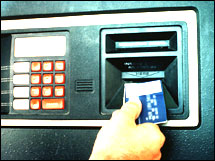|
Fewer fees could mean more deposits Banks are on the hunt to attract more deposits by slashing fees for consumers. But is it a smart move for the bottom line? NEW YORK (CNNMoney.com) -- If you slash fees, they will come. Bank deposits, that is. And that's a philosophy increasingly gripping the banking industry as more and more banks look to attract depositors by offering free checking accounts and no-fee ATM service to consumers.
Given the increasingly competitive landscape - with high-yield online bank accounts stealing market share - retail banks have to fight tooth-and-nail to draw traffic to their stores. And that means innovative, consumer-friendly products. But even a good strategy has some pitfalls, at least in the short term. "To some degree, there is a revenue hit from these kind of initiatives," said Madhavi Mantha, senior analyst at independent research and consulting firm Celent LLC. "But the whole goal, especially from free checking, is to gain deposit customers and that is financially more important than any hit they have from waiving fees." And to that end, some banks are already seeing success. Washington Mutual (Charts), for instance, recently touted its free checking initiatives at its investor day in Seattle. The company's free-checking program, which also eliminates fees for using out-of-network ATMs and gives customers 3 cents back for debit card signature purchases, was launched in March and has already resulted in 400,000 new checking accounts, executives said. WaMu is hoping to open 1.2 million new checking accounts by the end of the year, said James Corcoran, president of WaMu's retail banking at the event. Near-term challenges TD Banknorth (Charts), however, is facing some challenges in the near term. The company launched its "Bank Freely" campaign in June, which eliminated fees for out-of-network ATM usage and refunds consumers any fees that other banks may charge them for using a TDBanknorth cards. For consumers, that's about $4 in savings each time they use an out-of-network ATM but can add up to some hefty losses in income for the company. "It's not an insignificant cost to the company," said Thomas Dyck, executive vice president of corporate marketing and small business at TDBanknorth, although he didn't provide exact figures. But he added that TDBanknorth is willing to take the short-term hit to profitability because the initiative has "dramatically increased traffic in our branches and we've opened new accounts." Still TDBanknorth recently warned that its third-quarter earnings would fall well below analysts' expectations, due in part to the fiercely competitive and increasingly expensive deposit environment. The bank also warned that fee income, which has helped banks offset some of the earnings lost to the higher interest rates they must pay on deposits, are also falling. Fee income is made up collectively of items such as investments, insurance, account fees and sales on loans. ATM fees generally make up a relatively small portion of total fee income, analysts said. But service charges on deposit accounts - such as fees related to maintenance of bank deposit accounts and ATM fees - have steadily grown over the last year, according to statistics from the FDIC. In the first half of the year, service charges on deposit accounts climbed to $17.6 billion from $16.4 billion in the first half of 2005. And those fees accounted for roughly 19 percent of total non-interest income for the banking industry - up from about 15 percent in in the first half of 2005, according to the FDIC. TDBanknorth's Dyck said the company couldn't break out how large a part of the company's income was derived from the waived ATM fees. "It's certainly eating somewhat into income, but our entire position is around acquiring new customers," he added. "We're taking a longer term view about the whole issue." Patience is a virtue It is a strategy that will require some patience for most players, said Gerard Cassidy, managing director of equity research at RBC Capital Cassidy said banks are counting on the likelihood that when customers open a deposit account, they will be also be inclined to develop other banking relationships in the future that will prove more profitable. "Customers that have multiple products with banks are less likely to leave those banks," he said. "But if customers only use the bank for those sale-priced products and don't purchase other products" that could impact profitability down the road. And that's why banks are going to have to be strategic if they plan to cut fees in order to draw consumers. "It's not appropriate for every company," said Jackie Reeves, managing director at Ryan Beck. "The industry is extremely revenue challenged and they are looking for specific niche products to add on customers." Commerce Bancorp (Charts), which long touted its free ATM services, has modified that policy in recent days. As of of this month, customers get up to 10 free withdrawals per month from non-Commerce machines, a company spokeswoman said. Those who maintain a minimum daily checking account balance of $2,500 never pay a fee and are reimbursed for ATM surcharges from other banks. The company's no-fee ATM service helped the NJ-based bank expand into new markets. For TDBanknorth, which recently purchased Hudson United Bancorp, cutting fees was also a strategic way to grow in a new market, Reeves said. And PNC Financial's (Charts) strategy was to encourage its current account-holders to consolidate multiple accounts with one PNC checking account by offering no-fee ATM services to those depositors with a minimum of $2,500 in their account. "In the grand scheme of things, is this the right strategy for banks?" Reeves said. "That remains to be seen." None of the analysts interviewed for this story own shares of the companies mentioned. -------------------------------------------------------------------------- |
|

